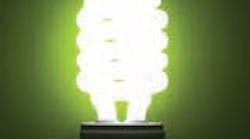With the start of the new year come new lighting regulations from the U.S. Dept. of Energy. Part of the energy efficiency legislation includes a mandated end to domestic manufacturing of non-efficient lighting and related products. This will change the way facilities consume energy and maintain lighting.
"There are plenty of myths out there that are causing some confusion and ambiguity surrounding the legislation, which could end up putting some businesses at a disadvantage," said John McDermott, brand strategy manager-sustainability at W.W. Grainger Inc., Lake Forest, Ill. "The lighting legislation is a unique opportunity for businesses to be more financially and operationally efficient, and facilities should embrace this shift and reap the benefits."
McDermott lists seven myths surrounding the lighting legislation and outlines some tools and resources that can help businesses ease into the transition.
Myth 1: The legislation won't impact commercial businesses as much as it will impact consumers.
Fact: The legislation will impact both residential and commercial buildings … and soon. Effective Jan. 1, 2012, standard 100W bulbs will require an increase of 30-percent in efficiency and can no longer be manufactured in the U.S. The requirements will also apply to 75W (effective 2013), 60W and 40W (effective 2014). For fluorescent tubes and PAR (parabolic aluminized reflector) bulbs, lighting that is found throughout most commercial buildings, the legislation is slated to go into effect on July 14, 2012.
Myth 2: The only monetary return your business will get from making the switch to efficient lighting is the decrease in energy use.
Fact: While energy and productivity savings from efficient bulbs are an obvious monetary benefit, businesses can take advantage of utility rebates that may be available at the state and local levels for additional savings. To find out what incentives are available in your area, visit http://www.dsireusa.org, which lists information on state, local, utility and federal incentives and policies that promote renewable energy and energy efficiency.
Myth 3: All lighting within a commercial facility will require costly retrofits to accommodate the shape and design of energy-efficient lighting.
Fact: While a significant amount of lighting that is unique to a commercial building, such as fluorescent tubes and PAR bulbs, will need some kind of retrofit, not all types of lighting will require a full modification. Halogen and incandescent bulbs, for example, can simply be replaced by newer technology, such as CFL and LED bulbs, with no retrofit required.
Myth 4: Making the switch to energy-efficient LED lighting is very expensive and will put a financial strain on your business.
Fact: While LED lighting is more costly than its inefficient counterparts at the onset of installation, the return over time can be significant. Not only can your business experience the cost savings that come with reduced energy consumption, productivity levels also may increase as you will not have to maintain lighting as frequently, due to the longer lifespan of LED replacement bulbs. No-cost resources are available to help you understand the savings potential for your business, such as savings calculators and estimators found at www.grainger.com/legislation.
Myth 5: There is no rush to accommodate the legislation because you can stock up on your current inefficient lighting and wait until you run out -- waiting will not add additional costs to your project.
Fact: Like government incentive programs, the utility rebates will not be available indefinitely. To help businesses prepare for the change, many lighting manufacturers and suppliers will be running promotions and other incentives to purchase energy-efficient lighting, which, similar to government incentives, may not be available once consumers and businesses adapt to the legislation and efficient lighting becomes standard. When updating the lighting in your facility, consider taking an approach that will align with your budget and comfort level. For example, start by identifying and changing out those bulbs that do not require a retrofit.
Myth 6: When evaluating lighting within your facility and determining the best way to approach the process, you are on your own.
Fact: While some facilities may have an in-house expert who is familiar with upgrading to energy-efficient lighting, many businesses do not know where to start. There are third parties that specialize in retrofitting and can identify the magnitude of potential savings, lay out a plan for the project and even execute the installation and apply for the appropriate utility rebates. Such a partner is Alliance Energy Solutions (http://www.alliance-energy.net), a Grainger company, which assists facilities in adapting to the lighting legislation and helps businesses maximize their energy savings.
Myth 7: The best way to dispose of inefficient fluorescent lighting is just to toss it in the trash.
Fact: Because florescent bulbs contain mercury, they may pose an environmental hazard when disposed of improperly. The best way to dispose of inefficient lighting is through recycling. If there are no recycling centers or drop-off locations in your area, you can purchase pre-labeled recycling kits that allow you to mail used bulbs to recycling centers to ensure proper disposal.
For more information about the lighting legislation and how your business can prepare for the impending changes, visit www.grainger.com/legislation.


